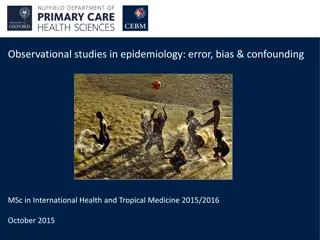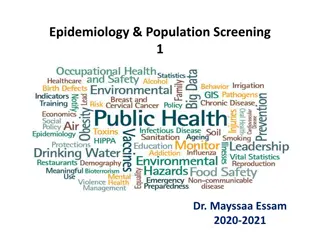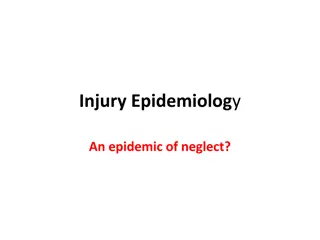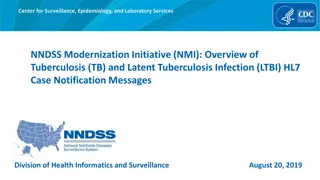
Epidemiology: Introduction and Basic Concepts
Explore the fundamental aspects of epidemiology, including its definition, historical development, methods of study, and focus on population health. Epidemiology seeks to understand the distribution and determinants of health-related events and their control in populations rather than individual health.
Download Presentation

Please find below an Image/Link to download the presentation.
The content on the website is provided AS IS for your information and personal use only. It may not be sold, licensed, or shared on other websites without obtaining consent from the author. If you encounter any issues during the download, it is possible that the publisher has removed the file from their server.
You are allowed to download the files provided on this website for personal or commercial use, subject to the condition that they are used lawfully. All files are the property of their respective owners.
The content on the website is provided AS IS for your information and personal use only. It may not be sold, licensed, or shared on other websites without obtaining consent from the author.
E N D
Presentation Transcript
King Saud University College of Business Administration Department of Health Administration Masters` Program PA 507 Introduction to Public Health First Semester 1437/ 1438 Mohammed S. Alnaif, Ph D. alnaif@ksu.edu.sa 1 Dr. Mohammed Alnaif 22/10/1446
EPIDEMIOLOGY INTRODUCTION AND BASIC CONCEPTS Learning Objectives Define epidemiology and describe what epidemiologists do within the area of public health. Outline historical developments important to the field of epidemiology. Identify the exposure and outcome in a public health research question. Describe the difference between descriptive and analytic epidemiology. Identify counts, proportions, and rates in reported data. Calculate the incidence rate or the prevalence of a health event in a population. 2 Dr. Mohammed Alnaif 22/10/1446
EPIDEMIOLOGY INTRODUCTION AND BASIC CONCEPTS Epidemiology Derived from the Greek words meaning study upon populations (epi = upon, demos = people, ology = study). This derivation does not convey what is studied or the nature of that study and is effectively the same as demography which is the study of the characteristics of populations, such as size, growth, density, distribution, and vital statistics. 3 Dr. Mohammed Alnaif 22/10/1446
EPIDEMIOLOGY INTRODUCTION AND BASIC CONCEPTS Epidemiology is the study of the distribution and determinants of health-related states or events (including disease), and the application of this study to the control of diseases and other health problems. Various methods can be used to carry out epidemiological investigations: surveillance and descriptive studies can be used to study distribution; analytical studies are used to study determinants. 4 Dr. Mohammed Alnaif 22/10/1446
EPIDEMIOLOGY INTRODUCTION AND BASIC CONCEPTS Epidemiology deals with the study of the causes, distribution, and control of disease in populations. Rather than focusing on the health of an individual person or a patient, epidemiologists focus on the health of groups of people. The field of epidemiology is a relatively young one, although the methods of statistics and other branches of mathematics, along with general scientific inquiry, form its basis. 5 Dr. Mohammed Alnaif 22/10/1446
EPIDEMIOLOGY INTRODUCTION AND BASIC CONCEPTS Epidemiology can be used in two broad ways: to describe where, when, and to whom a health event occurs or to quantify the amount of risk associated with a particular exposure or behavior. Epidemiologists use a variety of measures to describe the health of populations and to identify risk factors for health outcomes and disease, including counts, proportions, and rates. 6 Dr. Mohammed Alnaif 22/10/1446
EPIDEMIOLOGY INTRODUCTION AND BASIC CONCEPTS Thus epidemiologists are concerned with understanding health outcomes not in individuals, but in populations, or groups of people. Typically, an epidemiologist investigates the relationship between two things: the exposure and the outcome of interest. In statistics, the exposure would be called the independent variable; it is the health behavior, toxic substance, or other event or material a person encounters or experiences. 7 Dr. Mohammed Alnaif 22/10/1446
EPIDEMIOLOGY INTRODUCTION AND BASIC CONCEPTS Epidemiology The outcome, on the other hand, is the dependent variable. In epidemiology, we are interested in understanding how the exposure changes the chance someone will experience the outcome. An outcome can be a disease or other health outcome, or it could be a health behavior. For example, if an epidemiologist is interested in whether smoking causes lung cancer, smoking is the exposure and lung cancer is the outcome. 8 Dr. Mohammed Alnaif 22/10/1446
EPIDEMIOLOGY INTRODUCTION AND BASIC CONCEPTS Epidemiology Likewise, an epidemiologist may investigate whether eating a specific type of food (exposure) causes infection with Salmonella (outcome). The research question determines whether a given behavior or health outcome is the exposure or outcome. In some cases, smoking could be an outcome. Perhaps an epidemiologist is interested in looking at whether teens in rural areas are more likely to start smoking compared to teens in urban areas. In that case, rural residence is the exposure and smoking is the outcome. 9 Dr. Mohammed Alnaif 22/10/1446
EPIDEMIOLOGY INTRODUCTION AND BASIC CONCEPTS Epidemiology An outcome does not have to be a disease state; it can be any health event or health outcome of interest to the investigator. Likewise, outcomes do not have to be negative. An outcome may be a positive health behavior, such as eating the recommended five servings of fruits or vegetables per day, or it may be a positive health outcome, such as giving birth to a baby who is considered normal weight. 10 Dr. Mohammed Alnaif 22/10/1446
EPIDEMIOLOGY INTRODUCTION AND BASIC CONCEPTS Epidemiologists may work to identify the causes of disease, also known as disease etiology. An underlying assumption is that diseases and health outcomes are multifactorial, or caused by many different variables or factors. These factors may be physical, such as a virus or bacteria; they may be inherent or individual, such as genetic components or demographic characteristics; or they may be environmental, including neighborhood characteristics or governmental policies. 11 Dr. Mohammed Alnaif 22/10/1446
EPIDEMIOLOGY INTRODUCTION AND BASIC CONCEPTS Epidemiologists, like other public health professionals, conceptualize health outcomes using the social ecological model described in Chapter 2. In addition to explaining disease etiology, epidemiologists commonly work to identify factors that increase or decrease a person s likelihood of having a particular health outcome. This leads to a second underlying assumption in epidemiology: health outcomes are not randomly distributed in a population. 12 Dr. Mohammed Alnaif 22/10/1446
EPIDEMIOLOGY INTRODUCTION AND BASIC CONCEPTS Epidemiology In other words, the multiple factors that cause a disease are measurable and identifiable. If health events occurred at random, the prevention work of public health would be futile. We know, however, that there are a multitude of variables that can be linked to health outcomes. Epidemiologists seek to find these variables so that they and other public health professionals can work to intervene and prevent poor health in populations. 13 Dr. Mohammed Alnaif 22/10/1446
EPIDEMIOLOGY INTRODUCTION AND BASIC CONCEPTS Epidemiology Epidemiologists also may study how a disease progresses over time, or its natural history, from onset, through treatment, and possibly to death. Furthermore, some epidemiologists work to compare different ways of preventing a health outcome or treating a disease to determine which methods are most effective. Finally, epidemiologists work to determine and describe how much of a health event or health outcome occurs in a population and also among whom it is more common. 14 Dr. Mohammed Alnaif 22/10/1446
EPIDEMIOLOGY INTRODUCTION AND BASIC CONCEPTS Epidemiology Ultimately, epidemiology is concerned with improving the health of populations. Therefore, a final area in which epidemiologists may work is promoting or developing public health policies that are based on the data epidemiologists collect and analyze. 15 Dr. Mohammed Alnaif 22/10/1446
EPIDEMIOLOGY INTRODUCTION AND BASIC CONCEPTS Epidemiology is often considered the key scientific underpinning of public health practice. Its functions are: 1. To discover the agent, host, and environmental factors which affect health, in order to provide the scientific basis for the prevention of disease and injury and the promotion of health. 2. To determine the relative importance of causes of illness, disability, and death, in order to establish priorities for research and action. 16 Dr. Mohammed Alnaif 22/10/1446
EPIDEMIOLOGY INTRODUCTION AND BASIC CONCEPTS Epidemiology is often considered the key scientific underpinning of public health practice. Its functions are: 3. To identify those sections of the population which have the greatest risk from specific causes of ill health, in order that the indicated action may be directed appropriately. 4. To evaluate the effectiveness of health programs and services in improving the health of the population. 17 Dr. Mohammed Alnaif 22/10/1446
EPIDEMIOLOGY INTRODUCTION AND BASIC CONCEPTS Descriptive Epidemiology can identify patterns among cases and in populations by time, place and person. From these observations, epidemiologists develop hypotheses about the causes of these patterns and about the factors that increase risk of disease. In other words, epidemiologists can use descriptive epidemiology to generate hypotheses, but only rarely to test those hypotheses. For that, epidemiologists must turn to analytic epidemiology. 18 Dr. Mohammed Alnaif 22/10/1446
EPIDEMIOLOGY INTRODUCTION AND BASIC CONCEPTS Analytic epidemiology is concerned with the search for causes and effects, or the why and the how. Epidemiologists use analytic epidemiology to quantify the association between exposures and outcomes and to test hypotheses about causal relationships. Epidemiology provides sufficient evidence to take appropriate control and prevention measures. 19 Dr. Mohammed Alnaif 22/10/1446
Two Broad Types of Epidemiology ANALYTIC EPIDEMIOLOGY DESCRIPTIVE EPIDEMIOLOGY Examining the distribution of a disease in a population, and observing the basic features of its distribution in terms of time, place, and person. Typical study design: community health survey (approximate synonyms - cross- sectional study, descriptive study) Testing a specific hypothesis about the relationship of a disease to a putative cause, by conducting an epidemiologic study that relates the exposure of interest to the disease of interest. Typical study designs: cohort, case-control 20 Dr. Mohammed Alnaif 22/10/1446
EPIDEMIOLOGY INTRODUCTION AND BASIC CONCEPTS Some Basic Concepts Perhaps the worst epidemic to ever inflict humanity was the outbreak of bubonic plague, or the Black Death, that swept through Europe in the middle of the fourteenth century. Yet as terrible as these figures are, two points are readily apparent. First, not everyone was affected. Even in Florence, Italy, the death rate was nearly 70 percent, but of course 30 percent of the populace was not affected. Second, the plague was not always present. It came in waves during a period of few years, disappearing in the winter and reappearing in the spring, until it finally faded from the scene. 21 Dr. Mohammed Alnaif 22/10/1446
EPIDEMIOLOGY INTRODUCTION AND BASIC CONCEPTS Some Basic Concepts The question this raises is why Why some people and not others? Why in 1347 and not the previous year? Why in the warm moths but not winter? Why humans and not dogs, and on and on? Let's take a look at some of the factors that might provide an explanation for some of these questions by using the plague and other disorders as models Agent, Person, Place, and Time 22 Dr. Mohammed Alnaif 22/10/1446
EPIDEMIOLOGY INTRODUCTION AND BASIC CONCEPTS Agents It seems as every time we open the newspaper, or watch TV we're greeted with news that something else is going to kill us. There are only certain things that are necessary etiologic factors for diseases- what epidemiologist calls Agent. Lilienfeld groups agents into four categories: 1. Nutritive agents 2. Chemical agents 3. Physical agents 4. Infectious agents. 23 Dr. Mohammed Alnaif 22/10/1446
EPIDEMIOLOGY INTRODUCTION AND BASIC CONCEPTS Nutritive agents Some nutritive agents can cause disease by an excess of them and others by deficiency. Too much cholesterol, for example may lead to coronary heart disease; too much salt may lead to hypertension; too much calcium may lead to kidney stones. On the other hand too little calcium can lead to osteoporosis. Chemicalagents Chemical agents may consist of allergens, Example paint, cleaning agents, various food dyes; or poison Example arsenic, carbon monoxide, overdose of tricyclic antidepressant. 24 Dr. Mohammed Alnaif 22/10/1446
EPIDEMIOLOGY INTRODUCTION AND BASIC CONCEPTS Physicalagents Ionizing radiation or ultraviolet light would be considered among the physical agents that can lead to health problems. Infectiousagents Perhaps the most well-known agents to health workers are infectious agents such as viruses (mumps, measles, Ebola virus and acquired immunodeficiency syndrome [AIDS]), bacteria (tuberculosis [TB], rheumatic fever, and syphilis), protozoa (malaria), or rickettsia (typhus, rocky mounting spotted fever). 25 Dr. Mohammed Alnaif 22/10/1446
EPIDEMIOLOGY INTRODUCTION AND BASIC CONCEPTS Person The first step in understanding a health outcome often includes descriptive epidemiology, which depicts the health event by person,place, and time variables. Person, or who variables, include the demographic characteristics age, sex, and race or ethnicity. For example, a health outcome may occur only among women, or it may affect children under the age of five more often than any other age group. It may impact people of a certain race, ethnicity, or country of origin more frequently than other groups. 26 Dr. Mohammed Alnaif 22/10/1446
EPIDEMIOLOGY INTRODUCTION AND BASIC CONCEPTS Person Agents are necessary to cause disease but they are not sufficient. Not everyone who is stung by a bee develops an anaphylactic reaction, and two people could be enjoying the same meal in in the same restaurant, but only one may spend the rest of the night in the emergency room. It is obvious that people differ in terms of their susceptibility or response to the agents; this is what we call person or host factors. 27 Dr. Mohammed Alnaif 22/10/1446
EPIDEMIOLOGY INTRODUCTION AND BASIC CONCEPTS Person Year of birth is somewhat different from age although the two are obviously related; your year of birth will put you in a birth cohort. What you and your birth cohort experience is determined in part by when you were born. Other host factors are modified or acquired with time, such as age itself and immunologic experience, whether achieved naturally through prior exposure, or artificially through inoculation. 28 Dr. Mohammed Alnaif 22/10/1446
EPIDEMIOLOGY INTRODUCTION AND BASIC CONCEPTS Person A third class of person factors is more transitory, like time-limited comorbid conditions, fatigue, or nutritional status. Such factors affect the person ability to survive an illness. Finally, some host factors depend on our behavior what we call lifestyle whether we exercise, how we make use of health services, what we eat, and so on. 29 Dr. Mohammed Alnaif 22/10/1446
EPIDEMIOLOGY INTRODUCTION AND BASIC CONCEPTS Place variables tell the where of the health outcome. Are rural populations more likely to experience the outcome compared to urban dwellers? Perhaps an illness strikes in settings where many people come into close contact, such as schools, prisons, or nursing homes. A physical factor such as a river or a salt marsh may be the center of a cluster of outcomes. All of these examples illustrate the use of place variables in describing a health outcome. 30 Dr. Mohammed Alnaif 22/10/1446
EPIDEMIOLOGY INTRODUCTION AND BASIC CONCEPTS Place Geographically restricted or widespread (pandemic) Relation to water or food supply. Multiple clusters or one. It is obvious that place, which is also referred to as environment, is rarely a direct factor in its own right. Rather, it reflects a host of other factors that are distributed geographically. The challenge to epidemiologist is, once having found differences in the prevalence of some disorder from one place to another, to discover what it is about the environment that gives rise to these variations. 31 Dr. Mohammed Alnaif 22/10/1446
EPIDEMIOLOGY INTRODUCTION AND BASIC CONCEPTS Environment (Place) Crowding Atmosphere Modes of communication phenomena in the environment that bring host and agent together, such as: 1. Vector is any agent (animal, or microorganism) that carries and transmits an infectious pathogen into another living organism. 2. Vehicle An inanimate intermediate in the indirect transmission of a pathogen from a reservoir or infected host to a susceptible host; vehicles include foods, clothing, and instruments. 3. Reservoir Any person, animal, plant, soil or substance in which an infectious agent normally lives and multiplies. 32 Dr. Mohammed Alnaif 22/10/1446
EPIDEMIOLOGY INTRODUCTION AND BASIC CONCEPTS TIME Finally, time, or when variables, provide information about trends in a health outcome across years or seasons, and in the case of infectious diseases, time variables may be used to help identify the source of an infection based on the timing of reported symptoms. Diseases such as influenza are cyclical in nature and commonly occur during specific seasons. Tracking the timing of influenza cases may alert public health officials to an early start to a flu season or to a possible epidemic or pandemic strain of the virus. 33 Dr. Mohammed Alnaif 22/10/1446
EPIDEMIOLOGY INTRODUCTION AND BASIC CONCEPTS TIME In other cases, there may be a point in time after which the outcome of interest became increasingly common. For example, a contaminated potato salad at a company picnic may lead to an outbreak of Salmonella. In this example, we might describe the outbreak epidemiology in reference to the day of the picnic and track and identify those who began exhibiting symptoms thereafter. In epidemiology, it is useful to monitor trends over time to understand the nature of health outcomes and to evaluate whether interventions or control strategies are having an impact because the time of their implementation is known. 34 Dr. Mohammed Alnaif 22/10/1446
EPIDEMIOLOGY INTRODUCTION AND BASIC CONCEPTS Analytic epidemiology Analytic epidemiology goes a step beyond a description of a health problem or health outcome and seeks to identify risk factors or protective factors for the outcome. A risk factor is any personal attribute, environmental exposure, or other feature of a person or his or her environment that increases the likelihood that he or she will experience a given health outcome. Protective factors are any of the same types of variables that reduce the chance a given outcome will occur. 35 Dr. Mohammed Alnaif 22/10/1446
EPIDEMIOLOGY INTRODUCTION AND BASIC CONCEPTS Analytic epidemiology Often, we use the term risk factor to include characteristics that impact the likelihood of a given outcome, whether positively or negatively. In order to identify and quantify risk factors, we design epidemiological studies. There are many types of studies, some of which will be detailed in the next chapter, but all studies share some basic characteristics. 36 Dr. Mohammed Alnaif 22/10/1446
EPIDEMIOLOGY INTRODUCTION AND BASIC CONCEPTS Analytic epidemiology Research studies begin with a question, such as one of the following: Are caregivers less likely than non-caregivers to have recommended cancer screenings? Are children whose parents wear bicycle helmets more likely to regularly wear a bicycle helmet compared to children whose parents do not use bicycle helmets? These research questions each include an exposure, the independent variable of interest, and an outcome, the dependent variable of interest. 37 Dr. Mohammed Alnaif 22/10/1446
EPIDEMIOLOGY INTRODUCTION AND BASIC CONCEPTS Analytic epidemiology In the first question, caregiving is the exposure and cancer screenings are the outcome. In the second question, parents helmet use is the exposure and children s helmet use is the outcome. The researcher next examines similar work that has been completed (literature review) on the topic and forms a hypothesis, a statement of the investigator s expectation of the relationship between exposure and outcome. Hypotheses are propositions about relationships between variables or differences between groups that are to be tested. 38 Dr. Mohammed Alnaif 22/10/1446
EPIDEMIOLOGY INTRODUCTION AND BASIC CONCEPTS Basic Epidemiological Measures Epidemiology deals largely with numbers, or quantitative data. There are many ways to express numbers of health events, and epidemiologists have a set of measures they typically use to report health numerically. You probably are familiar with many of these already, although the terminology for some measures may be new to you. 39 Dr. Mohammed Alnaif 22/10/1446
Epidemiologic Measurements Used to Describe Disease Occurrence Measures of disease frequency in mathematical quantity Count Proportion (percentage) Rate Ratio Measures of disease frequency in epidemiology Prevalence Incidence 40 Dr. Mohammed Alnaif 22/10/1446
Epidemiologic Measurements Used to Describe Disease Occurrence Count One simple way to report health data is to provide a count. For example, in 2015 there were 219 cases of Measles reported in Saudi Arabia. Although this simple count does provide some information about Measles in Saudi Arabia, it would be much more helpful if we had additional information, a denominator, to go along with this count. 41 Dr. Mohammed Alnaif 22/10/1446
Epidemiologic Measurements Used to Describe Disease Occurrence Importance of Denominator a Numerator b Denominator Example 500 cases of dengue fever in Jeddah 120 cases of dengue fever in Abha Which city is more infected with dengue fever ? Jeddah: 500/2,000,000 = 0.25/1,000 Abha: 120/300,000 = 0.4/1,000 42 Dr. Mohammed Alnaif 22/10/1446
Epidemiologic Measurements Used to Describe Disease Occurrence Counts Simplest & most basic measure absolute number of persons who have disease or characteristic of interest. Useful for health planners & administrators: for allocation of resources (e.g. quantity of beds needed by a community) Count of No. cases of a disease, is used for surveillance of infectious disease for early detection of outbreaks. 43 Dr. Mohammed Alnaif 22/10/1446
Epidemiologic Measurements Used to Describe Disease Occurrence Basic Epidemiological Measures RATES, RATIOS, AND PROPORTINS In epidemiology, the occurrence of a disease or condition can be measured using rates and proportions. We use these measures to express the extent of these outcomes in a community or other population. 44 Dr. Mohammed Alnaif 22/10/1446
Epidemiologic Measurements Used to Describe Disease Occurrence Basic Epidemiological Measures RATES, a rate is a measure of the frequency with which an event occurs in a defined population over a specified period of time. Because rates put disease frequency in the perspective of the size of the population, rates are particularly useful for comparing disease frequency in different locations, at different times, or among different groups of persons with potentially different sized populations; that is, a rate is a measure of risk. 45 Dr. Mohammed Alnaif 22/10/1446
Epidemiologic Measurements Used to Describe Disease Occurrence Basic Epidemiological Measures RATES, RATIOS, AND PROPORTINS In epidemiology, the most important tool for measuring disease is the rate, but we also use ratios and proportions. A ratio expresses the relationship between two numbers in the form x : y or x/y 46 Dr. Mohammed Alnaif 22/10/1446
Epidemiologic Measurements Used to Describe Disease Occurrence Basic Epidemiological Measures A ratio is the relative magnitude of two quantities or a comparison of any two values. In a ratio the value of a variable, such as sex (x = female, y = male), may be expressed so that x and y are completely independent of each other, or x may be included in y Female/male or x/y 47 Dr. Mohammed Alnaif 22/10/1446
Epidemiologic Measurements Used to Describe Disease Occurrence Proportion Rates tell us how fast the disease is occurring in a population. Proportions tell us what fraction of the population is affected. A proportion is the comparison of a part to the whole. It is a type of ratio in which the numerator is included in the denominator. 48 Dr. Mohammed Alnaif 22/10/1446
Epidemiologic Measurements Used to Describe Disease Occurrence Proportion By dividing the number of cases of Measles in 2015 by the number of Saudi residents in 2015, we get the proportion of Saudi residents who had Measles in 2015: Proportion of Saudi population with Measles in 2015: 7 in 1,000,000 219 X 100,000 = 0.69/100,000 31,521,418 49 Dr. Mohammed Alnaif 22/10/1446
Epidemiologic Measurements Used to Describe Disease Occurrence Proportion A proportion is a specific type of ratio, in which x is a portion of the whole, x + y, in a proportion the numerator is always included in the denominator. Female/(male + female) or x/(x + y) X X + Y Proportions tell us what fraction of the population is affected. 50 Dr. Mohammed Alnaif 22/10/1446















